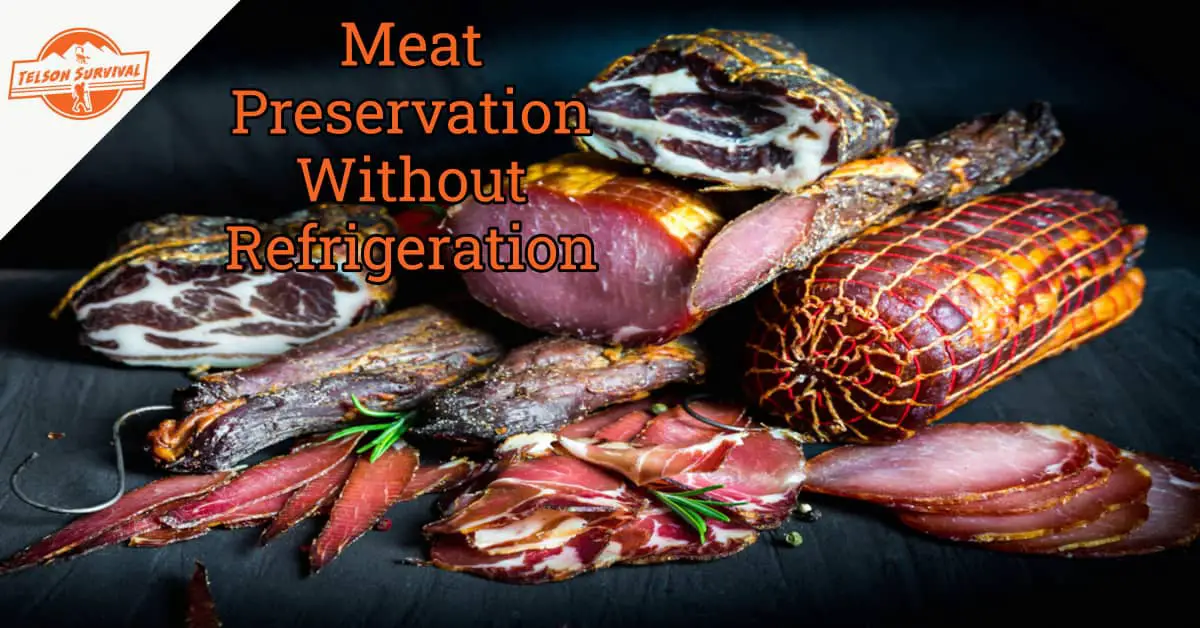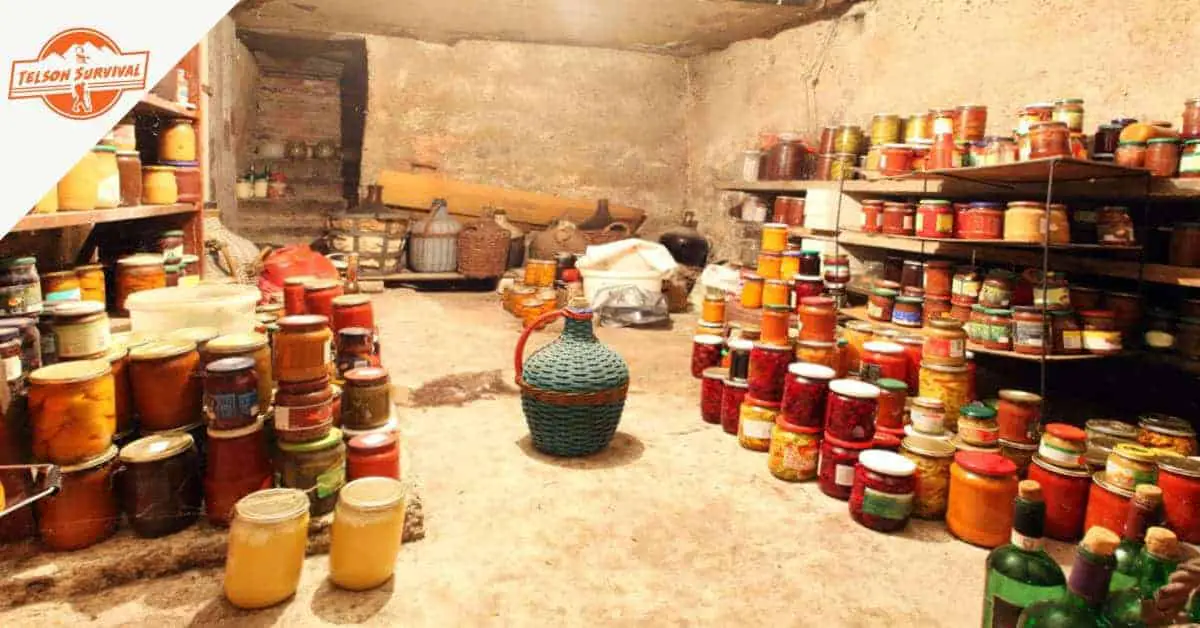One of the skills that we have let slip through our fingers in modern times is the art of preserving our food without refrigeration. Traditional meat preservation methods, in particular, have been lost because of the fear associated with food poisoning and rancid meat. And if we are honest with ourselves, it is so easy to just store meat in the freezer.
But wait a minute. Storing meat near or below freezing may not be an option if SHTF and the grid goes down. And is it even safe to store meat without refrigeration? Absolutely!
The first modern freezers weren't invented until the 1940s. Mechanical refrigeration had been around for nearly 100 years by then, and people had been keeping their food fresh and cold with ice boxes since the early 1800s. That's only 220 years of human history!
It's safe to assume that people were storing meat without refrigeration before then. And we can assume that it was safe to do so. If it was safe then, it's safe now. Most of us have just never learned how to do it. And we argue that storing meat without refrigeration is one of the most important skills every prepper needs to learn.
Preserving meat boils down to mastering a few key meat preservation methods that will allow you to safely enjoy consuming your meat weeks, months, or even years after processing it. There are easy ways to store meat without salt, preserve meat in jars, and salting meat to be cured for aging.
Here is the complete list of long term meat preservation methods for preppers without a freezer:
How to Keep Meat From Spoiling
The main reason that people avoid traditional meat preservation methods is that they fear their meat will spoil. And if it doesn't outright spoil, there's always a nagging fear of contamination that could lead to food poisoning.
These are very valid concerns, so it's worth addressing them right off the bat. Knowing how and why meat spoils will help you understand exactly why these methods work.
What Causes Meat Spoilage?
When handling fresh meat, all of the safety measures we follow have the main purpose of avoiding contamination by bacteria and other microorganisms.
These are the main culprits in causing the meat to go off and are the root cause of food poisoning.
Refrigeration helps stop these microorganisms from reproducing quickly. Freezing will stop them in their tracks. Unfortunately, many of these bacteria and molds can reactivate upon thawing.
Mold and bacteria thrive in warm, humid conditions. When you utilize traditional meat preservation methods, you will neutralize the effects of microorganisms by eliminating them altogether or by creating an environment where they simply cannot thrive.
Oxidation
Oxidation is another factor that causes meat to go rancid. Oxygen causes a reaction in the fat particles in meat. This reaction produces strong sour smells and a rotten taste.
This is why simple exposure to air can cause the meat to go off.
Traditional meat preservation techniques work because:
A.) You limit the exposure to oxygen, or
B.) You create an inhospitable environment for microorganisms, or
C.) You eliminate all microorganisms and create a sterile environment.
What Meats Can Be Stored Without Refrigeration?
Traditional farm meats such as beef, pork, rabbit, mutton, and poultry of all kinds along with game meats such as venison, fish, and bear meat can all be processed for long-term storage without refrigeration.
Not all methods work quite as well for every kind of meat though.
Several factors determine which meat preservation methods will work best.
- The fat content of the meat.
- The texture of the meat.
- Your planned use for the meat.
- How long you plan to store it.
We'll discuss each of these factors and which meats work best for each method as we delve into the details below.
The Importance Of Salt For Meat Preservation
No matter which meat preservation method you choose, you will need to keep salt on hand. Canning or freeze-drying are the only ways to preserve meat without salt, and it is actually recommended that you use at least a little bit. Other methods like curing and brining require quite a bit.
It is safe to say that lots of salt should be included in your survival supply cache. Why is salt so effective for preserving foods?
First off, it minimizes the amount of water in foods. Salt draws out moisture and binds to the remaining water molecules in the meat. This creates an inhospitable environment for microorganisms.
Most importantly, salt actually kills many microorganisms that may be contaminating the meat through a process called osmotic shock. This basically causes a dramatic loss of water in their cells. If they don't outright die, they certainly suffer and cannot grow as fast.
At the same time, salt helps the process of lactic acid bacteria. By creating a low oxygen environment, healthy fermentation can occur, creating delicious results.
Best Types Of Salt For Curing Meat
When doing your research and looking up recipes for preserving meats, you may notice that different types of salt will frequently show up.
- Table salt - standard iodized table salt. This is not the ideal option for preserving meats because it often includes anticaking agents. It will work, however, in a pinch. Just make sure you eventually cook the meat you will be curing.
- Sea salt - salt that is made from evaporated seawater. Non-iodized sea salt can be used for the different meat preservation methods if you wish to avoid nitrates. Note: If you use sea salt, your cured meats will not have that appealing pink color that you may expect.
- Kosher salt - usually packaged as a coarser crystal, kosher salt is basically non-iodized table salt. It gets its name because it is used for the koshering of meat. This can be used for curing meat, but only if it does not contain anticaking agents or fillers.
- Saltpeter - the original curing salt, saltpeter is actually potassium nitrate and has been used for hundreds of years to both preserve meat and tenderize it. Its biggest flaw when preserving meat is that it tends to result in inconsistent quality.
- Pink salt - not to be confused with Himalayan pink salt, pink salt has been produced and on the market for about 100 years exclusively for the use of curing and preserving meats.
Pink salts are colored pink so that you will not confuse them for table salt.
They contain certain ratios of sodium nitrates or sodium nitrites and are considered the safest salts for curing meats. This is because of how effective they are at limiting the growth of bacteria and other microorganisms (particularly botulism).
There are multiple brand names for pink salt, but all are labeled either #1 or #2. #1 is for meats that you will be cooking eventually and #2 is used for meats that you will not be cooking, such as prosciutti hams and dried sausages, i.e., products that will be cured for a very long time.
Follow your recipe's guidelines for which salt to use.
It would be a grave error to assume that meat cannot be preserved if you don't have access to specialized curing salts.
Sea salt is a good all-purpose salt that can be used for all the processes described below. As preppers, we must know how to improvise. In a post SHTF world, pink salts may be impossible to come by.
Sea salt, on the other hand, is easily produced and should be readily traded even after markets as we know them collapse.
That being said, use the salt of your choice when learning how to store meat without refrigeration. Make sure to do your research and carefully follow your recipes.
Best Meat Preservation Methods (Without Refrigeration)
#1 - Meat Canning
Benefits of canning meat:
- You can preserve every kind of meat.
- Preserves meat without salt or low salt content.
- Meat is ready-to-eat out of the jar.
- Canned meat has a very long shelf life.
Drawbacks of canning meat:
- Requires specialized equipment and tools.
- Canned meat takes up a lot of space.
Of all of the survival food preservation methods, canning one of the best options for preserving meat without refrigeration. If you have the equipment, you can create emergency meals ready to eat out of the jar. Even the toughest of meats will turn out tender after the process of pressure canning.
Canned meat, poultry, and fish have the taste, texture, and salt content similar to a freshly prepared meal, even after a couple of years in storage!
One of the best aspects of canning meat is that you can consume it right away. There is no need to wait for the meat to cure or age. Canning is also the ideal method for processing brined or fermented meats for long-term storage.
We recommend that you check out our guide to pressure canning meat, poultry, or fish in our article The 6 Best Methods for Survival Food Preservation.
All meat must be processed in a pressure canner for at least 90 minutes to eliminate any danger of botulism poisoning. Canned meats taste best when eaten during the first five years.
#2 - Dehydrating Meat
Benefits of meat dehydration:
- Can be done in nearly every survival situation.
- Is possible to do with no complicated equipment.
- Reduces the size of the meat, making it lightweight, compact, and portable.
- Can be combined with other meat preservation methods to increase efficiency and taste.
Drawbacks of meat dehydration:
- Concentrates salt content in the meat.
- May require reconstitution for it to be edible.
- If not stored correctly it can spoil.
- Does not work with every kind of meat.
Drying down meat is another excellent way to store meat without refrigeration.
The subject of how to dehydrate meat is a big one. We actually have a series of articles dedicated to the subject that you should check out, starting with our guide Dehydrating Survival Food. Follow up with The Best Foods to Dehydrate for Preppers, paying special attention to the part specific to meat.
To keep it brief for this article, we´ll summarize. If you are planning to dehydrate your meat, you need to keep the following tips in mind:
- Choose the leanest meats and cut off all excess fat.
- Slice the meat thin. If you have the option to partially freeze the meat, it helps.
- Make sure to briefly salt cure, brine, or marinade your meat before dehydrating it. You may also consider smoking it.
Smoking adds flavor and has preservative qualities that prevent microbial contamination.
You can actually fully dehydrate your meat by smoking it, but if you choose to dehydrate it through a different technique, lightly smoking it is still a good idea.
- The drier it is, the longer meat can be stored without refrigeration. Flexible and chewy jerky will not keep as long unrefrigerated as completely dried meat will. It all depends on what you want.
- Store your dehydrated meat in well-sealed containers, preferably using mylar bags with oxygen absorbers or a vacuum-sealed bag. This will extend its shelf life by reducing light exposure and oxygen contamination.
- Certain meats are not appropriate for dehydrating. Anything fatty or marbled (here's looking at you - pork) should be avoided.
The best meats for dehydrating include lean beef, breast meat from chicken or turkey, venison, elk, or bison.
Dehydrating is one of the best meat preservation methods because it can be done in the comfort of your own home just as easily as it can be done in a wilderness survival situation.
#3 Meat Curing and Charcuterie
Benefits of curing meat:
- Create delicious processed meat products that keep indefinitely.
- Perfect for fatty meats like pork, beef, certain fish, goose, or duck.
Drawbacks of curing meat:
- Requires a lot of salt.
- Certain recipes require a lot of time.
- If not done properly can result in contaminated meat.
- May not work in every climate without special infrastructure.
The terms 'curing' and 'charcuterie' represent meat preservation methods that are really variations of the same concept. Depending on what you are curing, there are different techniques and processes involved.
The basic idea is to remove the moisture from the meat through salting, occasionally smoking, and then drying it in a cool and slightly humid environment.
Curing not only preserves meat without refrigeration but actually turns your meat into a completely new product with a distinct texture, flavor, and color.
Some well-known cured meats, like prosciutto ham, require lots of time to reach the height of their deliciousness - up to two years! These meats lose between 35% and 45% of their moisture before they are ready to eat. Other meats, such as bacon, can be cured in as little as a week.
Curing meat often becomes an obsessive hobby for those who do it because you end up with some amazingly delicious food. But in a survival situation, knowing how to do it could be a logistical necessity and an essential survival skill.
If you are interested in curing meats for long-term storage, we recommend that you dig deeper into the subject by reading Home Production of Quality Meats and Sausages by Stanley and Adam Marianski. They really dive deep into every aspect behind the science of this traditional meat preservation method.
Last update on 2024-12-09 / Affiliate Links / Images from Amazon Product Advertising API
#4 Storing Meat in Lard or Confits
Benefits of storing meat in lard:
- Is perfect for storing fatty meats like pork, certain cuts of beef, goose, or duck.
- Requires less salt than brining or curing.
- The meat is pre-cooked and ready to heat up and eat.
- The meat retains its fresh flavor and texture.
Drawbacks of storing meat in lard:
- Requires cool/cold temperatures.
- Has a shorter shelf-life than dehydrated or cured meat.
You may have heard about the old-time method of storing pork in lard. But did you know that the same technique has been used for centuries to preserve other fatty meats and wild game?
The idea is simple. Seal off the meat from contaminants and the environment around it with its own fat. It's a genius method to keep your meat fresh without a refrigerator.
For pork, it's pretty simple. Here's the process of storing pork meat in lard:
- Cook the cuts of meat as if you were planning on eating it immediately. Go a little heavy on the salt.
- Transfer the meat into a ceramic, metal, or glass container and then cover the meat with melted lard. Make sure the meat is fully submerged.
- Let the lard firm up a bit before adding each layer. There should be a solid layer of lard between every layer of meat.
- When you've reached the top of the crock, top it off with an inch of additional lard.
- Use a tight-fitting lid and place the crock in the root cellar or in a cool location.
- When taking out meat, always make sure that the lard is pressed down and completely covering the remaining meat.
- Heat up the pork and enjoy!
Pork preserved in this method can last over six months as long as the temperature doesn't get too warm. When it comes to other fatty meat and game birds, the process is pretty much the same.
Traditional recipes call for the use of preserving spices such as bay leaves, pepper, sage, and lots of salt.
The meat is slow-cooked at a low temperature (never fried!) in its own fat and water. You should add additional fat to make sure the meat is fully submerged. The water will eventually boil off.
After all traces of water have evaporated, place the meat in an appropriate container and cover it with the strained fat. Store it in a cool area, and it will keep for a couple of months.
#5. Freeze Drying Meat
Benefits of freeze drying meat:
- Provides the longest shelf life of all meat preservation methods.
- Requires little effort.
- Meat can be preserved raw or pre-cooked.
- No salt needed!
- Decreases the weight of the meat
- Easy to reconstitute.
Drawbacks of freeze drying meat:
- Depending on where you live, may require very expensive equipment.
Freeze drying is, by far, the easiest and most efficient way to preserve meat without freezing or a refrigerator.
It is actually one of the most traditional methods to preserve meat and other foods. Unfortunately, unless you live in a climate where it is below freezing year-round, you are going to need a freeze-drying machine.
These machines are pricey, but if your goal is to prep as much emergency food as possible, it may very well be worth the investment.
Home freeze dryers are incredibly easy to use. Just slice your meat thin and put it in the machine. With the simple touch of a button or two, the machine does all of the work for you.
To store your freeze-dried meat, place it in a sealed container with an oxygen absorber to be on the safe side. Mylar bags or vacuum-sealed jars are ideal.
Freeze-dried meat can last upwards of 25 years when properly stored. There are no other meat preservation methods that guarantee such a long shelf life.
Smoking Meat As A Preservation Method
Did you notice that we didn't give smoking its own place number?
Cold smoking your meat until it is dry enough to store is a fantastic method for dehydrating it. This works particularly well if you need to preserve meat in the wilderness or live in a damp or cloudy environment where other methods of dehydration might be impossible.
But smoking, in and of itself, is a practice that complements all of the other traditional methods of meat preservation.
As we've mentioned, smoke has antimicrobial and preservative properties that aid in conserving meat. At the same time, it contributes an amazing flavor. You can smoke your meat before further processing it using any of the above meat preservation methods.
Preserving Meat In Brine
Brining is a meat preservation method that infuses salt into the meat through a liquid solution. Brining can be done before dehydrating or air curing, or it can be done in preparation for canning like in the case of corned beef.
Storing meat in brine gives it amazing flavor and texture while simultaneously extending its shelf life before you get around to cooking it. It is not, however, the preferred method for meat preservation when it comes to the long-term storage of meat.
Think of it as a temporary solution or a stepping stone in the processing of your meat without refrigeration. A cut of meat left in brine should be processed after about a month, maximum.
Rotating Meat In Your Long Term Stockpile
When you are stockpiling your survival food, it's considered good practice to create a rotation system so that foods do not expire on you. When you preserve your meat without a refrigerator, you need to do the same thing.
Know which methods work for short-term preservation, and which ones you can use in a pinch to put up an unexpected windfall. It is important to consume your preserved meats strategically so that nothing goes bad. The goal is to minimize waste.
Back in the day when traditional meat preservation methods were common practice, people knew what to eat first. Here's a quick list of steps to consume your preserved meat in rotation:
- Start with the meats with the shortest shelf-life; dehydrated jerkies, confits, or meat stored in lard or tallow.
- After those are consumed, start in on the drier meats, or those that are cured for short amounts of time.
- Leave the canned meats and cured cuts for the long term.
- Cycle through your food and create a system for replacing it. If you have a survival farm or seasonally hunt, this will depend on your butchering cycle. If you are purchasing meat in bulk, identify what you will be consuming first and then come up with a plan to process the rest.
Meat Preservation For Preppers Without Freezers
When it comes to storing meat for the long term, there is obviously more than one way to skin a cat.
Everything depends on the type of meat you are wanting to preserve, how long you need it to keep for, your personal taste preferences, and the tools you have at your disposal.
In this day and age, it is easy and convenient to just keep everything in the freezer. But for whatever reason, that freezer might malfunction if the grid goes down, and then you´ll be in a pinch.
Learning these simple techniques will help you build resiliency to withstand any glitch in the system. When SHTF you will be confident and capable when it comes to stretching your food and making it last. Having the skills to keep yourself and your family safely fed through hard times is priceless.











